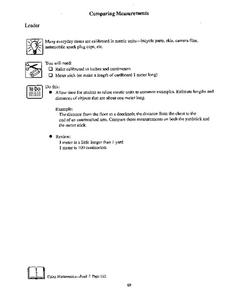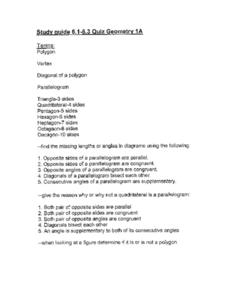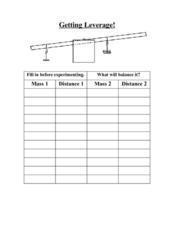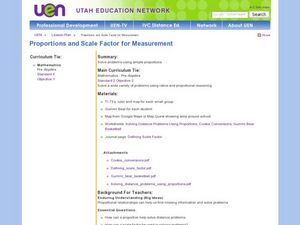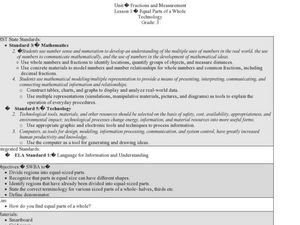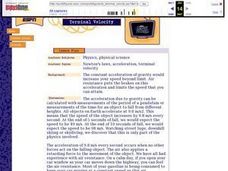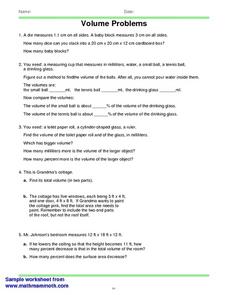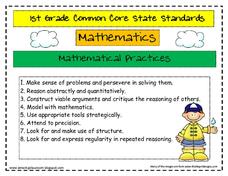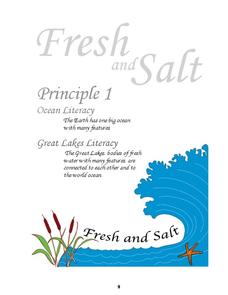Curated OER
Comparing Measurements
Young scholars use a ruler or meter stick to practice their metric unit and estimation skills by measuring everyday objects. First, students estimate the measurements of five distances as larger or smaller than a meter. Young scholars...
Curated OER
Mass
Students determine how mass is a property of an object that can be measured, and examine how size affects mass. They work with balances and determine what units of measurement are associated with mass. Finally, they determine the...
Curated OER
The Librarian Who Measured The Earth
Students use small objects as a unit of measurement for larger objects. Working in small groups, they measure the circumference of smaller spheres and estimate the circumference of larger spheres using these measurements. Students...
Curated OER
Polygons and Angle Measurement
In this polygons and angle measurement worksheet, students identify polygons and determine the measurement of each angle of the polygon. They identify parallelograms and justify why objects are or are not polygons. This four-page...
Curated OER
Measuring Leverage on a Balance
In this measuring leverage on a balance worksheet, students use this data sheet to record the mass and the distance for two objects on a balance as part of a science experiment.
Curated OER
Proportions and Scale Factor for Measurement
Students explore the concept of proportion. In this proportion lesson, students use google maps to find the distance the their school is from home. Students discuss what a scale factor is through teacher led discussion. Students...
Curated OER
Fractions and Measurement
Using a Smart Board, or a plain ol' white board or chalkboard, the teacher pulls up a grid and demonstrates how squares and rectangles can be divided up into equal parts. The class will get their own graph paper to draw shapes and divide...
Curated OER
Terminal Velocity
Learners calculate acceleration due to gravity with the measurements of the period of a pendulum or measurements of the time for an object to fall from different heights. They observe and measure the effect of air resistance on the...
Curated OER
Understanding Proportions and Scale Drawings
Proportions are ratios found using multiplication or division. Middle schoolers solve measurement problems, find a figure's missing dimension, and find the distance between two points. Resource features four lesson plans with detailed...
Texas State Energy Conservation Office
Investigation: Conservation of Energy
By rolling marbles down a six-foot length of track, physical scientists determine how much energy is lost to heat. It is recommended that you opt for the foam pipe insulation track because more friction slows the marble, allowing...
Curated OER
Physics of Roller Coasters
Students design a roller coaster and demonstrate their knowledge of Potential and Kinetic Energy. They determine the average velocity a given marble travels on their roller coaster and apply their knowledge of various measurement systems...
Utah Education Network (UEN)
Candies R Us
A box is fun to make, especially when it's a candy box! These activities help to cement understanding of the difference between surface area and volume. Have individuals measure the surface area of their box in two-dimensions before...
Curated OER
Determining the Density of a Liquid
Students find the density of diet soda and regular soda. In this density lesson plan, students measure the mass of a graduated cylinder with 10 different volumes of each soda. They find the mass of the liquid alone and use the volume to...
Curated OER
Applied Science - Science and Math Post Lab
Learners utilize a balance scale. In this applied science lesson, students compare the weights of two objects using an elementary balance scale. Learners balance the scale with weights to find how heavy an object is.
Curated OER
Solar Kit Lesson # 12 - Calibration Curve for a Radiation Meter
Scientists need to have mastered algebraic slope-intercept concepts in order for this instructional activity to be effective. They will measure and graph solar panel output as a function of the amount of radiation striking it,...
Math Mammoth
Volume Problems
In this volume problem instructional activity, students determine the volume of various objects. They compare similar objects and determine the percent of increase and decrease of the surface area and volume. This one-page instructional...
Curated OER
Newton's Second Law
In this Newton's Second Law worksheet, students answer 13 questions about force, mass and acceleration. They calculate weight, force, masses and acceleration of objects.
Curated OER
Our Solar System and Seasons
Sixth graders investigate the relative diameters of planets and distances between them and the cause for seasons on Earth using the 5-E Learning Model. They appreciate the size and distances involved with objects in the real universe....
Curated OER
Common Core State Standards 1st Grade Math
Here are the complete set of the math practice standards and the Common Core standards for first grade. They cover operations & algebraic thinking, operations in base 10, measurement and data, and geometry. Illustrated nicely with...
Curated OER
When a Ruler is Too Short
Students measure distances using parallax. In this math lesson, students explain how this method helped astronomers with their studies of the solar system. They determine the length of their arm using parallax and compare it with other...
Scientific American
Life-Sized Drawing
Ocean explorers or mathematicians research the wreck of the CSS H.L. Hunley. They investigate the actual dimensions of the Hunley using math and measuring skills. Afterward, they sketch a large scale drawing of the submarine outdoors on...
Centers for Ocean Sciences
Ocean and Great Lakes Literacy: Principle 1
Is your current lesson plan for salt and freshwater literacy leaving you high and dry? If so, dive into part one of a seven-part series that explores the physical features of Earth's salt and freshwater sources. Junior hydrologists...
Science 4 Inquiry
Expanding the Universe
When Einstein first heard the theory of the expanding universe, he dismissed it as bad physics. Now scholars learn about the theory and how scientists prove it has merit. Through a hands-on simulation and videos, class members measure...
Curated OER
Find It!
Young scholars consturct cube trains and use them to measure the length of selected objects in their classroom. They first "guess" with their eyes and then hold up a cube to check their guess.


